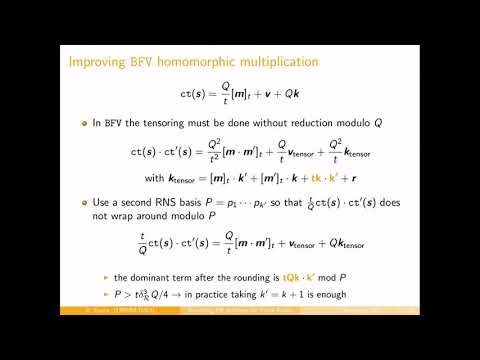CryptoDB
Revisiting Homomorphic Encryption Schemes for Finite Fields
| Authors: |
|
|---|---|
| Download: | |
| Presentation: | Slides |
| Conference: | ASIACRYPT 2021 |
| Abstract: | The Brakerski-Gentry-Vaikuntanathan (BGV) and Brakerski/ Fan-Vercauteren (BFV) schemes are the two main homomorphic encryption (HE) schemes to perform exact computations over finite fields and integers. Although the schemes work with the same plaintext space, there are significant differences in their noise management, algorithms for the core homomorphic multiplication operation, message encoding, and practical usability. The main goal of our work is to revisit both schemes, focusing on closing the gap between the schemes by improving their noise growth, computational complexity of the core algorithms, and usability. The other goal of our work is to provide both theoretical and experimental performance comparison of BGV and BFV. More precisely, we propose an improved variant of BFV where the encryption operation is modified to significantly reduce the noise growth, which makes the BFV noise growth somewhat better than for BGV (in contrast to prior results showing that BGV has smaller noise growth for larger plaintext moduli). We also modify the homomorphic multiplication procedure, which is the main bottleneck in BFV, to reduce its algorithmic complexity. Our work introduces several other novel optimizations, including lazy scaling in BFV homomorphic multiplication and an improved BFV decryption procedure in the Residue Number System (RNS) representation. We also develop a usable variant of BGV as a more efficient alternative to BFV for common practical scenarios. We implement our improved variants of BFV and BGV in PALISADE and evaluate their experimental performance for several benchmark computations. The experimental results suggest that our BGV implementation is faster for intermediate and large plaintext moduli, which are often used in practical scenarios with ciphertext packing, while our BFV implementation is faster for small plaintext moduli. More precisely, we propose an improved variant of BFV where the encryption operation is modified to significantly reduce the noise growth, which makes the BFV noise growth somewhat better than for BGV (in contrast to prior results showing that BGV has smaller noise growth for larger plaintext moduli). We also modify the homomorphic multiplication procedure, which is the main bottleneck in BFV, to reduce its algorithmic complexity. Our work introduces several other novel optimizations, including lazy scaling in BFV homomorphic multiplication and an improved BFV decryption procedure in the Residue Number System (RNS) representation. We also develop a usable variant of BGV as a more efficient alternative to BFV for common practical scenarios. We implement our improved variants of BFV and BGV in PALISADE and evaluate their experimental performance for several benchmark computations. Our results suggest that BGV is faster for intermediate and large plaintext moduli, which are often used in practical scenarios with ciphertext packing, while BFV is faster for small plaintext moduli. |
Video from ASIACRYPT 2021
BibTeX
@inproceedings{asiacrypt-2021-31389,
title={Revisiting Homomorphic Encryption Schemes for Finite Fields},
publisher={Springer-Verlag},
doi={10.1007/978-3-030-92078-4_21},
author={Andrey Kim and Yuriy Polyakov and Vincent Zucca},
year=2021
}

